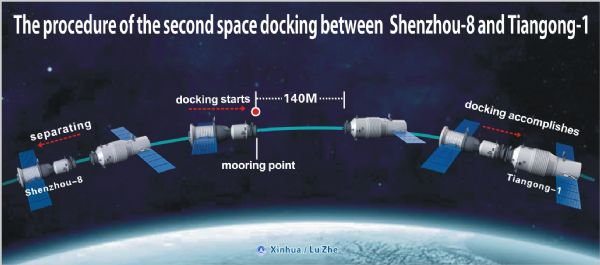(Ecns.cn) -- China's Shenzhou-8 unmanned spacecraft successfully separated and re-docked with the space lab module Tiangong-1 on Monday evening, according to the mission's control center.
The second docking lasted about 30 minutes.
The Shenzhou-8, launched on Nov. 1, rendezvoused and docked two days later with the already-in-orbit Tiangong-1 module, completing China's first space-docking.
Tiangong-1 has been in orbit since its launch on Sept. 29.
Advanced separating and docking technology for spacecraft, two commonly adopted means in space engineering, could "make China's future in the transportation of goods and astronauts between spacecraft and the space lab run much smoother," according to Wang Wenbao, the director of the China Manned Space Engineering Office.
The seventh and also the last comprehensive drill for the landing of Shenzhou-8 concluded at the space facility's major landing area at 8:55 pm on Sunday, proving that all the equipment and required personnel are ready for the landing of the unmanned spacecraft on November 17, according to the Beijing Times.
Meanwhile, the Tiangong-1 Spacecraft Operation Management Committee, lead by the general commander and chief designer of the manned space engineering project, was recently established to ensure the long-term operating plans, technology evaluation, and the aerospace flight control of the lab module.
In an earlier occasion, the country's manned space program spokeswoman Wu Ping told a press conference that China's spacecraft would conduct two more space docking missions in 2012 and begin to build a space lab and space station after that, with its first manned space station to be put in place around 2020.


















